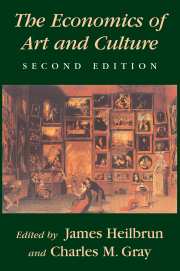Book contents
- Frontmatter
- Contents
- List of figures and tables
- Preface
- Part I The arts sector: Size, growth, and audiences
- 1 An overview of the arts sector
- 2 Growth of the arts sector
- 3 Audiences for the arts
- Part II The microeconomics of demand and supply
- Part III The fine arts and museums
- Part IV Public policy toward the arts
- Part V Art, economy, and society
- Index
2 - Growth of the arts sector
Published online by Cambridge University Press: 05 September 2012
- Frontmatter
- Contents
- List of figures and tables
- Preface
- Part I The arts sector: Size, growth, and audiences
- 1 An overview of the arts sector
- 2 Growth of the arts sector
- 3 Audiences for the arts
- Part II The microeconomics of demand and supply
- Part III The fine arts and museums
- Part IV Public policy toward the arts
- Part V Art, economy, and society
- Index
Summary
Because the arts industry is crucial to our self-image, we are naturally curious not only about its size, but also about its rate of growth. If it is growing rapidly, we are likely to think better of the state of our society than if it is growing slowly or not at all. We begin this chapter by tracing the growth of the live performing arts in the United States since 1929, with special attention to the impact of technological innovation. We then examine recent trends in Canada, Australia, and Western Europe. In this context, the principal forms of the live performing arts – theater, symphony, opera, and dance – can readily be analyzed in common. Growth of activity in the fine arts and the growth of art museums is taken up separately in Chapters 9 and 10.
Although we may all agree that the arts are more than “mere entertainment,” they are a form of entertainment, nevertheless, and must compete with its other forms in the budgets of interested consumers. The historical perspective adopted in this chapter allows us not only to measure the arts' long-run growth, but also to see how they have fared in competition with other kinds of recreation, and especially with other forms of spectator entertainment. In addition, it shows us how well the live arts have stood up against the endless flow of technological innovations, from talking pictures through television to the compact disc and the videocassette recorder, that have transformed the nonlive entertainment industry over the same span of years.
- Type
- Chapter
- Information
- The Economics of Art and Culture , pp. 11 - 39Publisher: Cambridge University PressPrint publication year: 2001



